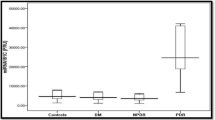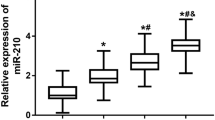Abstract
Diabetic retinopathy is the most severe ocular complication of diabetes and may lead to visual disability and blindness. Proliferative diabetic retinopathy (PDR) is characterized by ischemia-induced neovascularization with associated complications. An association was established between the presence of PDR, cardiovascular disease, and mortality among patients with type 1 diabetes mellitus and type 2 diabetes mellitus in epidemiological studies. However, the mechanism underlying increased cardiovascular risk in patients with PDR is still unknown. In recent years, a group of miRNAs has been linked to the pathology of diabetes mellitus. Besides, miRNAs in biofluids such as serum have been suggested as potential minimally invasive biomarkers of diabetes and vascular complications. This was a prospective study that recruited 40 human subjects: 10 healthy subjects, 10 with diabetes but without retinopathy (NDR), 10 with diabetic non-proliferative retinopathy (NPDR), and 10 with proliferative diabetic retinopathy (PDR). To examine whether serum miRNAs show altered levels at different stages of diabetic retinopathy, seven specific miRNA candidates (miR-126-3p, miR-130a-3p, miR-21-1, let-7f-5p, miR-122, miR-30c and miR-451a) were measured by qRT-PCR in RNA isolated from sera of all subjects. miR-122 levels increased in parallel with retinopathy severity: from healthy controls to NDR and from NDR to NPDR. However, when the disease progressed to PDR a marked decrease in miR-122 level was noted. This decrease was significant both compared to NPDR samples (p = 0.016) and to all non-PDR samples (p = 0.0002). Additionally, a positive trend was observed comparing miR-122 levels and the number of endothelial progenitor cells in the sera of all subjects. A significant increase in miR-122 was found in patients with diabetic retinopathy that may be related to its role in preventing angiogenesis and proliferation. The dramatic decline in patients with PDR may represent an inhibition or exhaustion of the anti-angiogenic anti-proliferative defense system. Further studies are needed to understand whether miRNA-122 has a role in the pathogenesis of diabetic retinopathy.


Similar content being viewed by others
References
Bluestone JA, Herold K, Eisenbarth G. Genetics, pathogenesis and clinical interventions in type 1 diabetes. Nature. 2010;464:1293–300.
Kahn SE, Cooper ME, Del Prato S. Pathophysiology and treatment of type 2 diabetes: perspectives on the past, present, and future. Lancet. 2014;383:1068–83.
Whiting DR, Guariguata L, Weil C, Shaw J. IDF diabetes atlas: global estimates of the prevalence of diabetes for 2011 and 2030. Diabetes Res Clin Pract. 2011;94:311–21.
Boyle JP, Thompson TJ, Gregg EW, Barker LE, Williamson DF. Projection of the year 2050 burden of diabetes in the US adult population: dynamic modeling of incidence, mortality, and prediabetes prevalence. Popul Health Metr. 2010;8:29.
Klein R, Klein BEK, Moss SE, Davis MD, DeMets DL. The Wisconsin epidemiologic study of diabetic retinopathy. II. Prevalence and risk of diabetic retinopathy when age at diagnosis is less than 30 years. Arch Ophthalmol. 1984;102:520–6.
Klein R, Klein BEK, Moss SE, Davis MD, DeMets DL. The Wisconsin epidemiologic study of diabetic retinopathy. II. Prevalence and risk of diabetic retinopathy when age at diagnosis is 30 or more years. Arch Ophthalmol. 1984;102:527–32.
Frank NR. Diabetic retinopathy. N Engl J Med. 2004;350:48–58.
Klein R, Klein BEK, Moss SE, Cruickshanks KJ. Association of ocular disease and mortality in a diabetic population. Arch Ophthalmol. 1999;117:1487–95.
Klein R, Klein BEK, Moss SE. The epidemiology of proliferative diabetic retinopathy. Diabetes Care. 1992;15:1875–91.
Tancredi M, Rosengren A, Svensson A-M, et al. Excess mortality among persons with type 2 diabetes. N Engl J Med. 2015;373:1720–32.
Blum A, Pastukh N, Socea D, Jabaly H. Levels of adhesion molecules in peripheral blood correlate with stages of diabetic retinopathy and may serve as bio markers for microvascular complications. Cytokine. 2017. https://doi.org/10.1016/j.cyto.2017.10.014 [Epub ahead of print].
Blum A, Socea D, Ben-Shushan RS, Keinan-Boker L, Naftali M, Segol G, Tamir S. A decrease in VEGF and inflammatory markers is associated with diabetic proliferative retinopathy. Eur Cytokine Netw. 2012;23(4):158–62.
Bartel DP. MicroRNAs: genomics, biogenesis, mechanism, and function. Cell. 2004;116(2):281–97.
Fernandez-Valverde SL, Taft RJ, Mattick JS. MicroRNAs in β-cell biology, insulin resistance, diabetes and its complications. Diabetes. 2011;60(7):1825–31.
Guay C, Regazzi R. Circulating microRNAs as novel biomarkers for diabetes mellitus. Nat Rev Endocrinol. 2013;9(9):513–21.
Shantikumar S, Caporali A, Emanueli C. Role of microRNAs in diabetes and its cardiovascular complications. Cardiovasc Res. 2011;93(4):583–93.
Pandey AK, Agarwal P, Kaur K, Datta M. MicroRNAs in diabetes: tiny players in big disease. Cellular Physiol Biochem. 2009;23(4–6):221–32.
de Candia P, Spinetti G, Specchia C, et al. A unique plasma microRNA profile defines type 2 diabetes progression. PLoS ONE. 2017;12(12):e0188980. https://doi.org/10.1371/journal.pone.0188980.
Rawshani A, Rawshani A, Franzen S, et al. Mortality and cardiovasculuar disease in type 1 and type 2 diabetes. N Engl J Med. 2017;376(15):1407–18.
Blum A, Pastukh N, Socea D, Hanin J. Colony forming unites-endothelial progenitor cells (CFU-EPCs): a surrogate marker for diabetic retinopathy and high cardiovascular mortality rate. Int J Pharma Res Rev. 2016;5(5):57–62.
Stegemann C, Pechlaner T, Willeit P, et al. Lipidpmics profiling and risk of cardiovascular disease in the prospective population-based bruneck study. Circulation. 2014;129:1821–31.
Willeit P, Kiechl S, Kronenberg F, et al. Discrimination and net reclassification of cardiovascular risk with lipoprotein (a): prospective 15-year outcomes in the Bruneck Study. J Am Coll Cardiol. 2014;64:851–60.
Zampetaki A, Willeit P, Tilling L, et al. Prospective study on circulating MicroRNAs and risk of myocardial infarction. J Am Coll Cardiol. 2012;60:290–9.
Kiechl S, Wittmann J, Giacceari A, et al. Blockade of receptor activator of nuclear factor-k B (RNAKL) signaling improves hepatic insulin resistance and prevents development of diabetes mellitus. Nat Med. 2013;19:358–63.
Willeit P, Willeit J, Brandstatter A, et al. Cellular aging reflected by leukocyte telomere length predicts advanced atherosclerosis and cardiovascular disease risk. Arterioscler Thromb Vasc Biol. 2010;30:1649–56.
Sever PS, Dahlof B, Poulter NR, et al. Prevention of coronary and stroke events with atorvastatin in hypertensive patients who have average or lower than average cholesterol concentrations, in the Anglo-Scandinavian Cardiac Outcomes Trial-Lipid Lowering Arm (ACOT-LLA): a multicenter randomized controlled trial. Lancet. 2003;361:1149–58.
Poulter NR, Wedel H, Dahlof B, et al. Role of blood pressure and other variables in the differential cardiovascular event rates noted in the Anglo-Scandinavian Cardiac Outcomes Trial-Blood Pressure Lowering Arm (ASCOT-BPLA). Lancet. 2005;366:907–13.
Stanton A, Fitzgerald D, Hughes A, et al. An intensive phenotyping study to enable the future examination of genetic influences on hypertension-associated cardiovascular disease. J Hum Hypertens. 2001;15(Suppl 1):S13–8.
Willwit P, Skroblin P, Moschen AR, et al. Circulating microRNA-122 is associated with the risk of new onset metabolic syndrome and type 2 diabetes. Diabetes. 2017;66(2):347–57.
Cortez-Dias N, Costa MC, Carrilho-Ferreira P, et al. Circulating miR-122-5p/miR-133b ratio is a specific early prognostic biomarker in acute myocardial infarction. Circ J. 2016;80:2183–91.
Gao W, He HW, Wang ZM, et al. Plasma levels of lipometabolism-related miR-122 and miR-370 are increased in patients with hyperlipidemia and associated with coronary artery disease. Lipids Health Dis. 2012;11:55–63.
Blum A, Yehuda H, Geron N, Meerson A. Elevated levels of miR-122 in serum may contribute to improved endothelial function and lower oncologic risk following bariatric surgery. IMAJ. 2017;19(10):620–4.
Burchard J, Zhang C, Liu AM, et al. microRNA-122 as a regulator of mitochindrial metabolic gene network in hepatocellular carcinoma. Mol Syst Biol. 2010;6:402. https://doi.org/10.1038/msb.2010.58.
Zhang Z, Li H, Chen S, et al. Knockdown of MicroRNA-122 protects H9c2 cardiomyocytes from hypoxia induced apoptosis and promotes autophagy. Med Sci Monit. 2017;23:4284–90.
Dhahri W, Dussault S, Haddad P, et al. Reduced expression of let-7f activates TGF-β/ALK5 pathway and leads to impaired ischaemia-induced neovascularization after cigarette smoke exposure. J Cell Mol Med. 2017;21(9):2211–22.
Author information
Authors and Affiliations
Corresponding author
Ethics declarations
Conflict of interest
The authors declare that they have no competing interests
Additional information
The first 2 authors share the first authorship.
Rights and permissions
About this article
Cite this article
Pastukh, N., Meerson, A., Kalish, D. et al. Serum miR-122 levels correlate with diabetic retinopathy. Clin Exp Med 19, 255–260 (2019). https://doi.org/10.1007/s10238-019-00546-x
Received:
Accepted:
Published:
Issue Date:
DOI: https://doi.org/10.1007/s10238-019-00546-x




